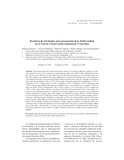Mostrar el registro sencillo del ítem
Recolecta de artrópodos para prospección de la biodiversidad en el Área de Conservación Guanacaste, Costa Rica
| dc.creator | Nielsen Muñoz, Vanessa | |
| dc.creator | Hurtado Hernández, Priscilla | |
| dc.creator | Janzen, Daniel Hunt | |
| dc.creator | Tamayo Castillo, Giselle | |
| dc.creator | Sittenfeld Appel, Ana | |
| dc.date.accessioned | 2015-10-22T16:53:16Z | |
| dc.date.available | 2015-10-22T16:53:16Z | |
| dc.date.issued | 2004 | |
| dc.identifier.citation | http://revistas.ucr.ac.cr/index.php/rbt/article/view/14760 | |
| dc.identifier.citation | http://www.ots.ac.cr/rbt/attachments/volumes/vol52-1/15-NIELSEN-119-132.pdf | |
| dc.identifier.issn | 0034-7744 | |
| dc.identifier.issn | 2215-2075 | |
| dc.identifier.uri | https://hdl.handle.net/10669/15282 | |
| dc.description | artículo -- Universidad de Costa Rica. Escuela de Biología, 2004 | es_ES |
| dc.description.abstract | This study describes the results and collection practices for obtaining arthropod samples to be studied as potential sources of new medicines in a bioprospecting effort. From 1994 to 1998, 1800 arthropod samples of 6-10 g were collected in 21 sites of the Área de Conservación Guancaste (A.C.G) in Northwestern Costa Rica. The samples corresponded to 642 species distributed in 21 orders and 95 families. Most of the collections were obtained in the rainy season and in the tropical rainforest and dry forest of the ACG. Samples were obtained from a diversity of arthropod orders: 49.72% of the samples collected corresponded to Lepidoptera, 15.75% to Coleoptera, 13.33% to Hymenoptera, 11.43% to Orthoptera, 6.75% to Hemiptera, 3.20% to Homoptera and 7.89% to other groups. Different life stages per arthropod species were obtained in most samples, 54.26% of them were adults, 19.90% corresponded to larvae, 6.46% to pupae, 6.12% to pre-pupae, 2.07% to nymphs and 3.74% to other stages. Other materials associated to insects like frass represented 11.20% of the samples collected. Several collecting methods were explored, based on the possibility of accessing the necessary amount of material causing the less impact. Most of the samples were obtained by manual collection (44.38%), followed by insects breeding (25.73%), light traps (18.80%), different types of nets (10.52%) and other methods (0.16%). In general, collecting methods and practices excluded the use of solvents, mixing different species or life stages in the same bag, which might have introduced undesirable effects in the screening systems for new compounds. Based on the possibility of finding new chemicals in similar samples associated to one arthropod species, the collecting strategy included the generation of several samples from same species, separated according to differences in life stages, collecting sites, ecosystems, seasons, feeding materials or behavioral aspects. This strategy allowed the generation a larger number of samples submitted to bioassays in different areas of pharmaceutical research. | es_ES |
| dc.description.abstract | Desde 1994 hasta 1997, 1800 muestras de artrópodoscorrespondientes a 642 especies distribuidas en 21 órdenes y 95 familias fueron recolectadas en 21 localidades protegidas del Área de Conservación Guanacaste, para ser estudiadas como fuente potencial de nuevos medicamentos. Las localidades con más recolectas fueron Santa María (231 spp.; 421 muestras), Santa Rosa (110 spp.; 172 muestras), Cacao (98 spp.; 203 muestras) y Pitilla (67 spp.; 79 muestras), siendo la mayor cantidad recolectadas durante la estación lluviosa. El 49.72% de las muestras recolectadas correspondió al orden Lepidoptera, 15.75% a Coleoptera, 13.33% a Hymenoptera, 11.43% a Orthoptera, 6.75% a Hemiptera, 3.20% a Homoptera y 7.89% a otros grupos. Además, un 54.26% de las muestras correspondía a individuos adultos, 19.90% a larvas, 11.20% a estiércol, 6.46% a pupas, 6.12% a prepupas, 2.07% a ninfas y 3.74% a otros estadios. Un 44.38% de las muestras se recolectó mediante recolecta manual, seguido por crianza de insectos (25.73%), trampa de luz (18.80%), diferentes tipos de redes (10.52%) y otros métodos (0.16%). La alta diversidad de los trópicos y la gran abundancia de artrópodos hace de este grupo una fuente potencial de productos farmacéuticos. Sin embargo, se debe evitar la recolecta intensiva en la misma localidad durante años consecutivos (sobre todo hembras), minimizar la interferencia en procesos vitales de los organismos y la dinámica de sus poblaciones. Además se debe recolectar la menor cantidad posible de individuos y escoger la época del año adecuada, para lograr el reestablecimiento natural de las poblaciones. | es_ES |
| dc.description.sponsorship | National Institute of Health (Fogarty International Center) No. 5U01TW/CA00312, facilitado por el proyecto NSF DEB 9400829 y DEB 9705072, D. H. Janzen | es_ES |
| dc.description.sponsorship | Universidad de Costa Rica, Vicerrectoría de Investigación, proyecto VI 801-96-582. | es_ES |
| dc.description.sponsorship | INBio | es_ES |
| dc.language.iso | es | es_ES |
| dc.publisher | Revista de Biología Tropical 52(1): 119-132, 2004 | es_ES |
| dc.subject | bioprospecting | es_ES |
| dc.subject | arthropods | es_ES |
| dc.subject | insects | es_ES |
| dc.subject | Guanacaste Conservation Area | es_ES |
| dc.subject | Costa Rica | es_ES |
| dc.subject | collecting methods | es_ES |
| dc.subject | Santa Rosa National Park | es_ES |
| dc.subject | Rincón de la Vieja | es_ES |
| dc.subject | National Parks | es_ES |
| dc.title | Recolecta de artrópodos para prospección de la biodiversidad en el Área de Conservación Guanacaste, Costa Rica | es_ES |
| dc.type | artículo original | |
| dc.description.procedence | UCR::Vicerrectoría de Docencia::Ciencias Básicas::Facultad de Ciencias::Escuela de Biología | es_ES |
| dc.identifier.codproyecto | 801-96-582 |
Ficheros en el ítem
Este ítem aparece en la(s) siguiente(s) colección(ones)
-
Biología [1644]
-
Revista de Biología Tropical Vol.52 (1) [1]


